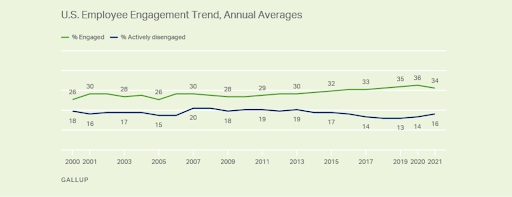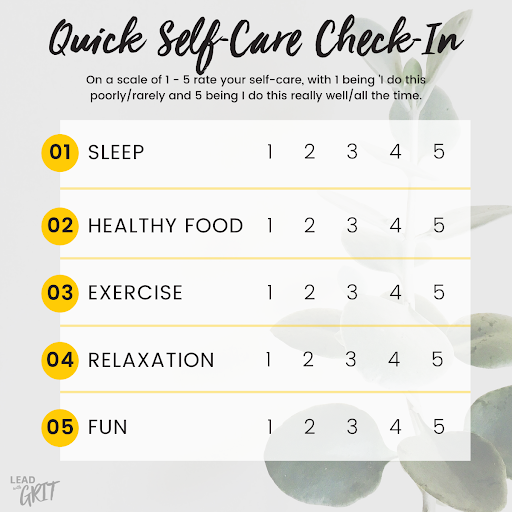Share:
Laurie Sudbrink, Contributor

Employee engagement has been the hot topic since I got into the field of training and development over 25 years ago. While we have seen improvement on this front, this year engagement has dropped for the first time in a decade.*

Throughout all the years I’ve worked with companies on employee engagement, and with my own personal experiences of being disengaged early in my career, there is one critical element that affects employee engagement the most. And research shows it still has the biggest impact today.
So what affects employee engagement the most? The short answer: YOU do.
Leaders affect employee engagement the most. A leader’s ability to authentically build relationships with team members, their level of self-awareness, their personal sense of accountability, as well as their health and well-being, can all have a significant impact on employee engagement.
In this article, we’ll explore why leaders have the most profound effect on employee engagement and share some tips on what leaders can do to become better at building relationships, improving self-awareness, and increasing their accountability.
I’ll also discuss how working on their health and well-being through self-care practices can improve a leader’s effectiveness and boost engagement.
The Employee Engagement Crisis
Yes, it’s true, leaders have faced unprecedented challenges in recent months, including record increases in employee quit rates, implementing vaccine mandates and new health protocols, and accommodating varied employee work preferences, to name a few.
Until recently, the in-person, on-site work model has dominated the workplace. 2020 changed all that, and now the hybrid work model (a mix of on-site and remote) is becoming the norm. It appears that 60-70% of the workforce will be adopting this model.
This presents even more challenges in accommodating everyone’s preferences while keeping employees engaged and meeting the company’s expectations.
Why Employee Engagement Makes a Difference
As we well know, employee engagement has a huge impact on how well organizations deliver on a variety of factors that determine success.
Employee engagement can affect how well teams perform, how productive they are, and how profitable a business is. It’s a necessary component of organizational sustainability.
Having high employee engagement is also very effective for recruiting and retaining talented, high-performing employees. Additionally, high engagement can improve employee health and wellness and the customer service employees provide.
Leaders play an important role in reinforcing an organization’s mission and providing feedback that helps them realize the impact they are making, which makes them feel instrumental in an organization’s success.
Leaders guide their teams in realizing the connection between their individual roles, shared core values, and organizational success by treating them like essential, valued members of the team, which boosts performance.
That boost in performance can lead to substantial increases in profits, with organizations with high employee engagement being 21% more profitable than organizations with low levels of engagement.
These high-performance, high engagement organizations also grow profits up to three times faster than their competitors!
One way engagement helps an organization’s bottom line is by reducing turnover and absenteeism by improving well-being. One of the leading drivers of employee engagement is employees’ belief that their leaders care about their well-being.
Employees who are healthier and less stressed out miss less work. And they are happier in their roles and more aligned with the organization’s values. As a result, they are better able to serve your clients.
The Single Biggest Variable in Employee Engagement
Oftentimes an organization may try to boost engagement levels by tweaking things that do in fact have a tremendous impact on employees, such as allowing for flexible schedules, adjusting pay or benefits, adding more training opportunities, providing childcare, and offering health and wellness programs.
While these factors do influence employee satisfaction and engagement, the single biggest variable is the immediate manager or supervisor.
In a recent podcast interview, I shared the seven most important things a leader needs to do to improve employee engagement. Those seven things essentially all fall within the realm of self-development.

Managers should have an interpersonal relationship with their direct reports and strive to create an environment where people can do their best. This relationship—and the perception of it—is the direct impact that will either make or break an organization’s level of employee engagement.
Leaders are responsible for establishing an environment of respect, trust, and communication. They create buy-in and shared ownership for group goals, motivate and inspire employees to excel and grow, and inspire pride in the organization.
If the last few years have proven anything about relationships, it’s that people need to feel connected, especially in times of crisis.
They need to be listened to.
They need to be acknowledged.
They need to feel like leadership has their back.
A leader cannot fake this type of connection. It must be authentic.
Why Managers May be Dropping the Ball
To understand why engagement is slipping we have to understand why managers may be dropping the ball.
A big factor may be a lack of self-awareness. Knowing yourself and accepting who you are can determine how well you deliver on the core values you espouse as a leader.
So much of it is about our mindset. Self-awareness and acceptance of being solid with ourselves helps us to be genuinely confident. And that confidence is what inspires other people and will keep your team engaged.
But we also have to consider that even leaders, like their employees, can become disengaged.
While there is much focus on disengaged employees and the toll they take on organizations, a disengaged leader can be just as destructive to an organization’s culture and overall success.
Even when employees enjoy the work they are doing, working for a disengaged leader can make them feel less satisfied in their jobs, and it can make building strong interpersonal relationships, which are necessary for maintaining trust, all but impossible.
This sort of leader disengagement has become an even bigger problem over the last few years.
If you were struggling before 2020, now throw on top of that one of the most life-altering events we’ve ever experienced. It’s no wonder that engagement levels are slipping as we all try to pick up the pieces and adapt to this “new normal.”
The truth is, in the last couple of years, many in leadership positions have become mentally burnt out—emotionally unavailable, even.
As such, many managers have avoided the issues their people are facing. They’re not making the time to listen and be present. Or they don’t know how to connect with their team remotely. Or they’re overwhelmed by trying to accommodate a wide range of employee preferences, including an increased demand for flexibility and a growing need for autonomy as hybrid work becomes the norm.
These are legitimate issues.
And who is holding the managers accountable? One poll showed that more than a third of managers are not held accountable for the engagement levels in their organization. This is where a 360 evaluation tool proves its value.
We know that personal authenticity and direct connection with each employee are fundamental to engagement levels. Tracking this helps provide accountability.
And leaders also need to hold themselves accountable. One way they can do this is by ensuring they are taking care of themselves as well as their employees.
In my experience, the leaders that are not taking care of themselves don’t have the drive or energy to be there for others. As simplistic as it sounds, the best way to help others is to help yourself first.
Take Care of Yourself So You Can Take Care of Them
We’ve discussed why it’s YOU who has the biggest impact on employee engagement. Now let’s explore what you can do to become your best self and a more effective leader.
It starts with taking care of yourself so you have the energy to take care of them.
Just as employees perform better when they are healthier mentally and physically, leaders are better at leading and engaging employees when they take the time to focus on maintaining their own mental and physical health.
Taking a holistic approach to improving your health is key to being the best leader you can be.
Holistic self-care (or lack thereof) is the most important factor that is, I believe, impacting leadership effectiveness. When leadership isn’t effective, employee engagement suffers.
What is holistic self-care?
In a nutshell, holistic self-care is devoting time on a regular basis to attend to your physical, emotional, intellectual, social, and spiritual well-being. Bringing each of these dimensions into balance will help you achieve personal fulfillment and transformation.
There are no shortcuts to excellence, and quick-fixes or coping mechanisms are not sustainable, nor do they benefit you in the long run. If you truly want to improve one area of your life you have to improve them all.
A healthy leader can make the biggest impact on employee engagement.
When it comes to your health, don’t make excuses. No one is responsible for your health but you. If it feels overwhelming, just start with the basics.
Sleep: It’s completely underrated and absolutely essential to overall health. Things that help me wind down are taking an evening walk, listening to some relaxing tunes, reading, and turning electronics off at least 2 hours before sleep. I also make it a point to look into natural light first thing in the morning as this helps align circadian rhythms.
Healthy food: Eating healthy can be easy and fun. I had to change my mindset about it by choosing to add healthy foods in, rather than taking food away. Depriving ourselves doesn’t usually motivate us to eat healthier.
Exercise: Just do something to move your body. I stretch for about 10 minutes in the morning and take walks, about 4 miles three times a week, and shorter walks daily.
Relaxation: Also called “stress-management.” I used to do yoga but find my dimple stretches do the trick for me. I also get a massage about every six weeks. And when I’m stressed, parasympathetic breathing calms me almost instantly. It’s really easy and can be done almost anywhere. Here’s how I do it:
- Slow, deep breath in, filling your lungs all the way, hold it for four seconds.
- Slowly release the air, empty your lungs all the way, hold it for four seconds.
- Repeat three times.
Fun: Yes, this is important! Admittedly I’d like more of this in my life. Fun for me is a live concert, getting together with friends for board games or a campfire, playing with my grandsons outdoors, and of course, laughing—the best medicine!
The habit of having fun, relaxing, and enjoying can help us not only bond as a team, but there is a lot of research to back up that it helps us be more innovative and creative.
How well do you rate your level of self-care? Take a moment to rate your self-care with this quick self-care check-in:

If you want to dive a little deeper and do a holistic self-care assessment, here’s a worksheet you can print or just refer to.
Whatever tools you use, the point is to take ownership of your health and strive for long-term success. Being and feeling healthy will have a greater impact on your leadership abilities than you can imagine. Health is the foundation of any great endeavor.
Having a healthy foundation provides us with the energy to be aware of our emotions, manage them appropriately, be cognizant of other people’s emotions, and respond appropriately. And that’s a recipe that really helps a leader engage their teams and keep them engaged.

Laurie Sudbrink is a leadership expert with over two decades of executive coaching, leadership training, and business experience. She is the founder of Unlimited Coaching Solutions, Inc. and the author of Leading With GRIT.


